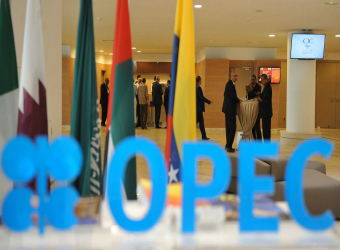Major oil CEOs urged Friday OPEC to extend output cuts beyond March next year, arguing “huge volatility” in the energy market meant it would be imperative for the cartel to try to put a floor under prices.
OPEC members are reportedly forming a consensus around extending their production cutting deal with other crude exporters by nine months. That would prolong the agreement among OPEC, Russia and other oil-producing nations to keep 1.8 million barrels a day off the market through the whole of next year.
The exporters reached the deal last December and have already extended the agreement once through March of 2018.
OPEC deal ‘working efficiently and should continue’
When asked whether it would be necessary for OPEC to prolong the agreement beyond March next year, Total Chief Executive Patrick Pouyanne told CNBC, “Of course they need it.”
He added “huge volatility in the market” had placed greater emphasis on stability and “visibility” from OPEC officials. Pouyanne also said oil prices were likely buoyed by the visibility provided by OPEC and non-OPEC officials in recent weeks.
OPEC is widely-expected to defer an announcement regarding an extension to cuts at its next policy meeting in November. Instead, investors are looking to March 2018 for a final decision.
“It is better to keep a stable policy and I think the OPEC and non-OPEC agreement is working efficiently and should continue,” Pouyanne said.
‘Short term exuberance does not characterize’ major oil CEOs
Speaking on the sidelines of the Oil and Gas Climate Initiative (OGCI) conference Friday, BP CEO Bob Dudley echoed the arguments put forward by his Total counterpart and said it looked “probable” OPEC would extend its agreement next year.
“I heard what Patrick (Pouyanne) said about the volatility of oil and the factors here and I couldn’t agree with him more … I think this is the world we are living in,” he said, before adding, “Short term exuberance does not characterize I think any of the CEOs that I know in oil and gas right now.”
The price of oil collapsed from near $120 a barrel in June 2014 due to weak demand, a strong dollar and booming U.S. shale production. OPEC’s reluctance to cut output was also seen as a key reason behind the fall. But, the oil cartel soon moved to curb production — along with other oil producing nations – in late 2016.
“I think that OPEC need to keep this position … It’s not just to balance demand but also to give an assurance to all the investors,” ENI Chief Executive, Claudio Descalzi, told CNBC on Friday.
Descalzi added investors needed to know OPEC and non-OPEC countries would continue to be “able to interact positively with the market to balance supply and demand” over the long term.
“We need stability and OPEC is really important” to achieving that beyond March next year, Descalzi concluded.
OPEC and the International Energy Agency (IEA) have recently reported that demand has improved, though the IEA raised concerns about future consumption growth in its latest report.
On Friday afternoon, WTI traded at $52.38 and Brent crude traded at $58.96.
Oil and Gas Climate Imitative
The OGCI, to which Saudi Aramco, BP, ENI and Total have all signed up, is a CEO-led enterprise which aims to lead the industry response to climate change.
In 2016, 10 major oil and gas firms signed up to the OGCI and said they had set up a $1 billion fund to support the development of new technology in order to combat greenhouse gas emissions.
The commitment to invest $1 billion over the next decade will be applied to carbon capture, use and storage technology as well as to cut methane emissions. The OGCI does not include support for renewable energies, such as solar and wind.
Source: CNBC



